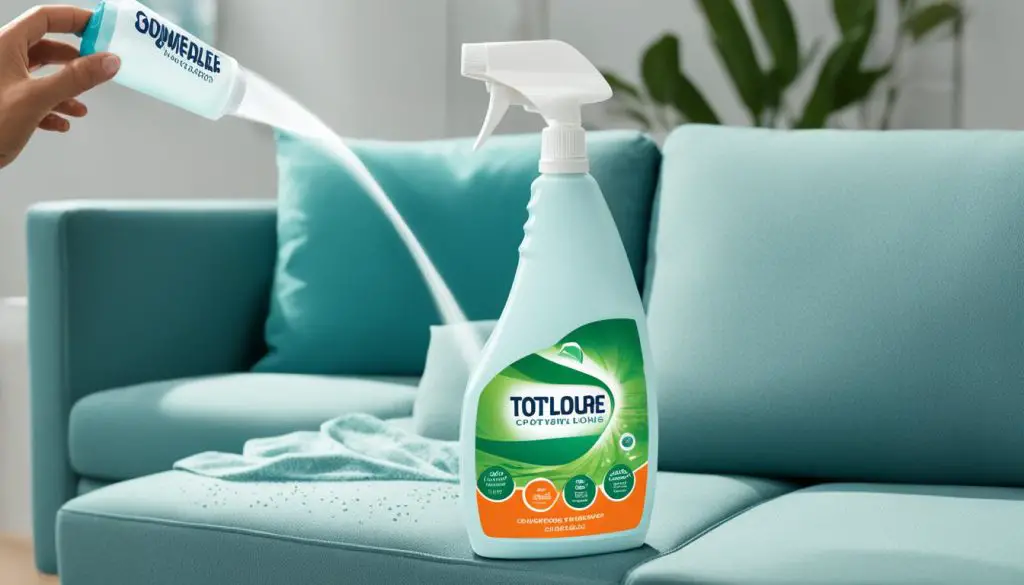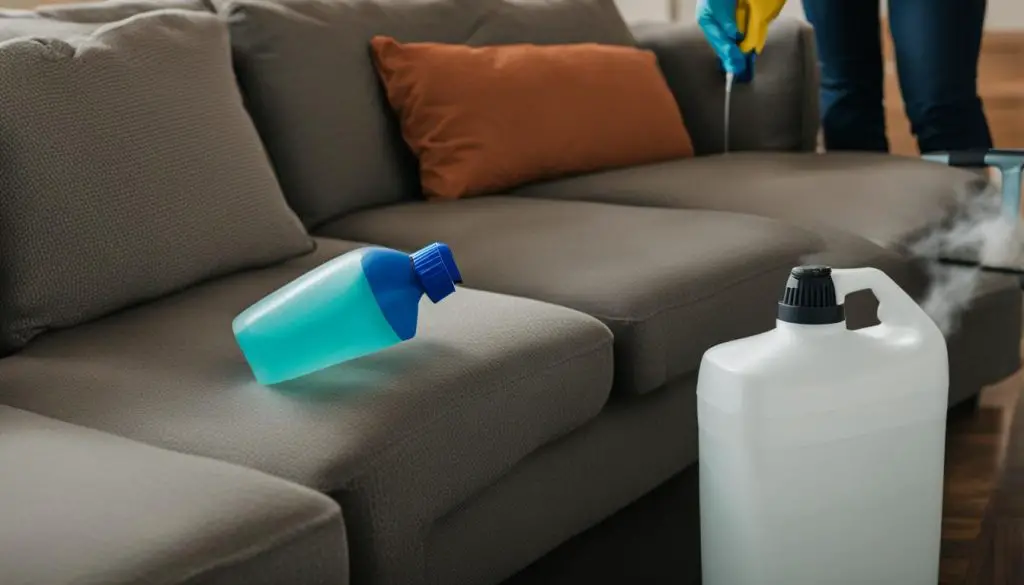Welcome to our guide on how to sanitize a couch. Keeping your couch clean and free from germs is essential for a healthy and hygienic living room environment. In this article, we will provide you with a 5-step plan to effectively sanitize your couch and ensure a fresh and comfortable seating area for you and your family.
Key Takeaways:
- Regular sanitization is crucial for maintaining a clean and healthy living room.
- Start by vacuuming the surface of the couch to remove any large particles and debris.
- Spot clean tough stains using a bristle brush and the appropriate cleaning products.
- Choose the right cleaning product based on the fabric type of your couch.
- Deep clean the fabric using the proper method, such as a steam vacuum or dry-cleaning solvent.
- Allow the couch to air-dry completely before using it again.
- Following this 5-step plan will help you maintain a fresh and hygienic couch for years to come.
Now, let’s dive into each step of the plan in more detail. By the end of this article, you’ll have the knowledge and tools to effectively sanitize your couch and enjoy a clean and comfortable seating area in your home.
Related: How to Get a Couch Through a Doorway: 6 Tips and Tricks
Step 1: Vacuum the Surface
Before deep-cleaning your couch, it’s important to remove any surface debris and large particles. This will ensure that the subsequent cleaning steps are more effective in sanitizing your couch. Follow these simple steps to vacuum the surface of your couch:
- Start by preparing your vacuum cleaner. If you have a dust-buster or a vacuum cleaner with a hose attachment, this will be particularly useful for reaching all areas of the couch.
- Begin by vacuuming the cushions and crevices of the couch. Use the hose attachment to thoroughly remove any dirt or debris that may have accumulated.
- Move on to the main body of the couch, paying attention to the armrests, backrest, and seating area. Ensure that you cover the entire surface to remove any loose dirt or dust.
Vacuuming the surface of your couch with a dust-buster or a vacuum cleaner with a hose attachment will help remove dirt and prepare your couch for a thorough sanitization. This step is particularly effective in removing surface debris and ensuring a clean foundation for the following cleaning processes.
Step 2: Spot Clean Tough Stains
For spots with heavy dust or dirt buildup, use a stiff-bristled brush to break up the dirt and vacuum up the released particles. Be careful not to damage the fabric while scrubbing. Additionally, use a lint roller to remove lint or pet hair that cannot be removed with a vacuum cleaner. This will help eliminate tough stains and ensure a clean couch.
When dealing with dirt that is caked into the fabric of your couch, a bristle brush can be your best friend. Bristle brushes with stiff bristles are perfect for loosening up dirt particles without harming the fabric. Gently scrub the affected areas with the bristle brush, working in a circular motion. This will help dislodge the dirt and make it easier to remove.
After using the bristle brush, vacuum up the released particles using a vacuum cleaner with a hose attachment. Make sure to reach all areas of the couch, including crevices and cushions. This step will effectively remove the loosened dirt from the fabric, leaving your couch cleaner and fresher.
In addition to heavy dust, your couch may also have stubborn stains that require spot cleaning. In such cases, spot cleaning can be done using a suitable cleaner or homemade solution that is safe for your couch fabric.
Tips for Spot Cleaning:
- Choose a cleaner that is safe for your couch fabric.
- Always test the cleaning solution on a small, inconspicuous area first.
- Follow the instructions provided by the manufacturer or consult a professional if unsure about the cleaning method.
- Use a bristle brush to gently scrub the affected areas and loosen the dirt.
- Vacuum up the released particles using a vacuum cleaner with a hose attachment.
- If necessary, use a lint roller to remove lint or pet hair that cannot be removed with a vacuum cleaner.

| Advantages of Using a Bristle Brush for Spot Cleaning | Disadvantages of Using a Bristle Brush for Spot Cleaning |
|---|---|
|
|
Choose the Right Cleaning Product for Your Fabric
Different sofa fabrics require different cleaning products. To ensure effective and safe cleaning of your couch, it’s important to choose the right cleaning product based on the fabric type. Here are the steps to follow:
- Look for the care tag on your couch to determine the fabric type.
- Identify the appropriate cleaning products to use based on the upholstery cleaning codes.
- Follow these codes to ensure effective and safe cleaning of your couch.
The care tag on your couch will contain upholstery cleaning codes that indicate the recommended cleaning method and products for your specific fabric. These codes typically include:
| Code | Cleaning Method | Recommended Products |
|---|---|---|
| W | Water-based Cleaning | A mild detergent and water solution |
| S | Dry Clean Solvent | Dry-cleaning solvent |
| S-W | Water-based or Dry Clean Solvent | A mild detergent and water solution or dry-cleaning solvent |
| X | Professional Cleaning | Professional upholstery cleaning services |
Step 4: Deep Clean with the Right Method
Once you have determined the appropriate cleaning method for your couch fabric, it’s time to deep clean and restore your couch to its former glory. Depending on the fabric type, you’ll need to follow specific procedures and use the right tools for effective cleaning. Here are the methods to thoroughly clean your couch:
Cleaning Water-Based Fabric:
For water-based fabric, start by pre-conditioning the fabric to loosen dirt and debris. Using a fabric pre-conditioner will help break down stains and make it easier to remove them. Follow the directions on the pre-conditioner bottle for the best results.
Next, prepare a solution of detergent and water. Mix a small amount of mild detergent with warm water in a spray bottle or bucket. Test the solution on a small, inconspicuous area of the fabric to ensure it doesn’t cause discoloration or damage.
Once the solution is ready, lightly spray it onto the stained areas of the fabric. Use a soft brush or cloth to gently scrub the fabric in a circular motion. Avoid applying too much pressure to prevent damaging the upholstery.
After scrubbing, use a steam vacuum to extract the dirt and detergent from the fabric. Move the steam vacuum over the fabric in slow, overlapping strokes, ensuring thorough cleaning. This process will help remove deep-seated dirt and eliminate any lingering odors.
Cleaning Dry-Clean Only Fabric:
If your couch has dry-clean-only fabric, follow these steps to remove stains:
Start by treating the stains with a dry-cleaning solvent. Apply a small amount of the solvent to a clean, white cloth or sponge. Gently blot the stained areas, avoiding excessive rubbing. Be sure to work from the outside of the stain towards the center to prevent further spreading.
Continue blotting the stains until they start to fade. Change to a clean area of the cloth or sponge as needed to avoid reapplying the stain. Once the stains are significantly reduced, allow the fabric to air dry.
If the stains persist after this initial treatment, it’s best to consult a professional upholstery cleaner for further assistance. They have the expertise and specialized equipment to handle tough stains on dry-clean-only fabrics.
Also read: How to Get White Towels White Again: Expert Washing Tips

Step 5: Allow the Couch to Air-Dry
After completing the cleaning process, it is important to allow the couch to air-dry completely. Air-drying is a crucial step in the drying process, as it ensures the thorough removal of excess detergent and promotes the restoration of your couch.
Do not use excessive force or heat to dry the fabric, as this may result in shrinkage or damage. Instead, let the couch air-dry naturally, which may take some time depending on the fabric and the humidity level of your environment. Patience is key in achieving optimal results and maintaining the integrity of your couch.

Air-drying has several advantages. Firstly, it allows the fabric to breathe and regain its natural texture and softness. Secondly, it helps to eliminate any residual moisture, preventing the growth of mold or mildew. Lastly, air-drying helps to preserve the color and patterns of the fabric, ensuring that your couch looks as good as new.
To facilitate the drying process, you can open windows or turn on fans to improve air circulation in the room. Remember to avoid direct exposure to sunlight, as prolonged exposure can cause fading or discoloration of the fabric.
In some cases, if the couch has removable cushion covers, you may consider removing them for separate air-drying. This will expedite the drying process and ensure that all parts of the couch are thoroughly dried.
| Benefits of Air-Drying: |
|---|
| 1. Preserves fabric texture and softness |
| 2. Prevents mold and mildew growth |
| 3. Maintains color and pattern integrity |
| 4. Saves energy |
Conclusion
Sanitizing your couch is crucial for maintaining a clean and healthy living room environment. By following these 5 steps, you can effectively remove dirt, stains, and odors from your couch, ensuring a fresh and hygienic seating area. Remember to choose the appropriate cleaning products for your specific fabric and allow the couch to air-dry completely before using it again.
FAQ
Why is it important to sanitize a couch?
Sanitizing your couch is essential for maintaining a clean and hygienic living room. It helps remove dirt, stains, and odors, creating a fresh and comfortable seating area.
How do I vacuum a couch?
Start by using a dust-buster or a vacuum cleaner with a hose attachment to remove large particles and surface debris. Make sure to reach all areas of the couch, including crevices and cushions.
What should I do for spots with heavy dust or dirt buildup?
Use a stiff-bristled brush to break up the dirt and vacuum up the released particles. Be careful not to damage the fabric while scrubbing. You can also use a lint roller to remove lint or pet hair that cannot be removed with a vacuum cleaner.
How do I choose the right cleaning product for my couch fabric?
Look for the care tag on your couch to determine the fabric type and the appropriate cleaning products to use. The upholstery cleaning codes on the tag will indicate whether to use water-based detergents, dry-cleaning detergents, or professional services for cleaning.
How do I deep clean my couch?
For water-based fabric, pre-condition the fabric to loosen dirt and debris. Then, use a solution of water and detergent to spot-test and clean the fabric with a steam vacuum. For dry-clean-only fabric, use a dry-cleaning solvent with a rag to remove stains.
How should I dry my couch after cleaning?
After completing the cleaning process, it is important to allow the couch to air-dry completely. Avoid using excessive force or heat to dry the fabric. Instead, let the couch air-dry naturally to prevent shrinkage or damage.






